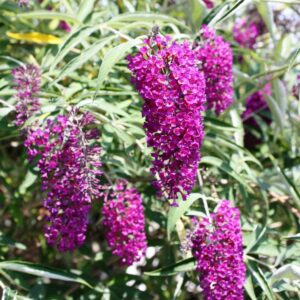Showing the single result
Wholesale Butterfly Bush
Butterfly bushes, also known as the Buddleia davidil, are grown for their beautiful colored flowers and their special ability to attract butterflies. These stunning bushes will bloom large clusters of flowers or flowering spikes in the spring until autumn. Although their blooming ends in the fall, these plants remain eye-catching all year long, even when they’re not in bloom.
The butterfly bush flowers come in many colors, including lavender, pink, yellow, and blue. You may even come across some multicolored bushes. Some butterfly bushes stay relatively small, while others can grow up to 12 feet tall!
About the Butterfly Bush
The butterfly bush was first brought to England from Asia in 1774. Currently, new varieties of the plant are being discovered in remote areas of China and the Himalayas.
In some areas of the United States, the butterfly bush is considered an invasive plant. Invasive plants can be problematic because they can alter ecosystems. However, keep in mind that they are not invasive everywhere. So, make sure you double-check your region to check if it is an identified problem before planting one yourself.
Growing a Butterfly Bush
The butterfly bush is stunningly beautiful, easy to grow, and fairly easy to maintain. They require full sun to grow, and they typically bloom between June to September. Don’t be surprised to see the bush blossom to shades of purple, pink, blue, white, and yellow. To help the butterfly bush thrive, keep them in medium moisture, well-drained soil.
Even during inclement weather conditions, the shrubs will remain standing tall. They’re also pretty resistant to insects, drought, and other stressful conditions. Just make sure that if you’re planting more than one bush, space them about 5 to 10 feet apart, depending on the variety.
How to Care For Your Butterfly Bush
Caring for your shrub couldn’t be easier! The butterfly shrub likes a medium-moisture environment. As long as they get 1/2 inch of water by rain or irrigation each week, they will continue to grow strong. If you’re hand watering your shrub, make sure you water it slowly and deeply, especially during prolonged dry spells, so that the soil can properly absorb the water deep into the roots.
Unless grown in poor soil, the butterfly bush doesn’t need to be fertilized. When the bush receives too much fertilizer, it can promote overwhelming leaf growth and flower production. Although you don’t always need to fertilize, you should prioritize deadheading your flowers. This process is probably the most labor-intensive when caring for your butterfly bush.
Deadheading Your Butterfly Bush
When deadheading your shrub, remove spent flower spikes to help encourage new flower buds. Deadheading is most beneficial during the spring and summer. If the flowers are left on the plant, they will quickly develop seed pods, which, when mature, will release their seeds and start to grow new little sprouts. These seedlings should be removed immediately to prevent an overwhelming growth of the bush.
When you’re removing the seedlings, keep in mind that young shrubs that are cut off at ground level can re-emerge. When you’re going to remove the young shrubs, make sure you’re going deep enough to remove the roots along with the top growth.
Propagating a Butterfly Bush
Although propagating is rare for the butterfly bush, all you need to do is collect the seeds heads and replant them wherever you desire. However, the butterfly bush normally spreads out readily, so there is never typically a need to propagate.
Keep in mind that there may be instances where it may not be possible to propagate. For example, if you choose a sterile, seedless variety of butterfly bush, propagation is not achievable.
Varieties of the Butterfly Bush
If you are planting a butterfly bush, be prepared to give it the maintenance that it needs. It’s very important to keep up with removing any spent flower heads to avoid overpopulating the bush. Some of the more common butterfly bushes you can find that spread seeds are the Buddleia x weyeriana and the Buddleja davidii.
Buddleia x weyeriana
This bicolor butterfly bush starts as a deep purple before opening to pink. As the flowers age, you’ll even notice that they turn to a peachy orange color.
Buddleja davidii
The ‘black knight’ is a butterfly bush cultivar. It has deep purple flowers that almost seem to be black.
Non-Seeding Butterfly Bushes
Because the butterfly bush can grow rapidly, non-seeding varieties have also been planted. Some of the more popular choices of non-seeding butterfly bushes include:
Buddleja x ‘Blue Chip’
This version of the butterfly bush grows between 3 to 6 feet. It’s smaller than your typical butterfly bush and doesn’t produce seeds.
Buddleja ‘Miss Ruby’
Growing pinkish-purple flowers, this butterfly bush grows about 4 to 5 feet tall and wide. This flower is fragrant and will attract butterflies and hummingbirds.
Other seedless varieties of the butterfly bush include:
- Asian Moon
- Ice Chip
- Inspired Pink
- Purple Haze
Butterfly Shrubs for Sale in Michigan
At Cold Stream Farm, we have wholesale butterfly bushes available for your landscaping. We are a wholesale/retail bare root tree and shrub nursery in Michigan. Contact us online today to learn more about our available butterfly bushes for sale!


